Water Provider Updates Supply Network Using Process Control Technology from Siemens
The municipal utility company Stadtwerke Annweiler in Germany supplies 13 communities encompassing some 16,000 residents with fresh water across its 130 square kilometer catchment area. To safeguard the continued supply of high-quality water to its customers, the time had come for the company to update the automation technology used in its water supply and wastewater treatment plants.

Stadtwerke Annweiler supplies 13 communities encompassing some 16,000 residents with fresh water across its 130 square kilometer catchment area. (Image: Stadtwerke Annweiler)
Stadtwerke Annweiler opted to use process control technology from Siemens for the project. The reliable control system installed enables the heterogeneous structure of the supply network comprising over 40 pumps, water treatment plants and overhead tanks to be visualized and monitored. The open architecture of the system also allows step-by-step migration, and the use of standard components facilitates both programming and the supply of spare parts.
Uninterrupted operation and long plant life cycles: these are the challenges faced by Stadtwerke Annweiler. To keep connected households supplied with a reliable flow of water at all times, remote stations provide information on a wide range of parameters such as water levels, network pressure and flow volumes. “Our existing system was increasingly reaching its limits, with ever more frequent faults involving ever more complex troubleshooting operations. Spare parts were getting more difficult and costly to come by, and we were coming up against restrictions which couldn’t be reconciled with our understanding of modern technology,” explains Stadtwerke Annweiler’s responsible project manager Sven Dausch. There was no alternative but to look for a new solution, and the company lost no time in opting for the Simatic PCS 7 process control system from Siemens.
Step by step
Right from day one, the company was impressed by the high level of standardization of the Siemens system and its open architecture facilitating the integration of components from other suppliers. This enabled step-bystep migration of the system. “Instead of modernizing everything in one fell swoop, this solution allows us to upgrade 2 to 3 stations a year and enables the gradual allocation of resources,” says Dausch. The same applies to resources invested in programming. While the predecessor system involved highly complex programming requiring specifically trained personnel, programming of the Simatic PCS 7 conforms to customary standards with Step 7 and STL (Statement List).
Advance testing for a smooth transition
In charge of the modernization project was certified Siemens Partner Stadler + Schaaf Mess- und Regeltechnik GmbH. The entire project including system layout was set up, checked and tested locally at the company’s head office. “By setting up a VPN (Virtual Private Network), we were able to access the existing server in Annweiler and so compare operating screens, alarms, signals and so on with our own work in the Simatic PCS 7,” explains Stefan Thyssen, one of the project managers involved at Stadler + Schaaf. Following successful testing and three weeks of parallel operation, the old system was decommissioned. Since then, a Simatic PCS 7 working in combination with a remote Tele-Control solution has been ensuring a reliable supply of water to the different communities, and provides wideranging diagnostic scope for precise troubleshooting in case of faults. The function blocks of the S7-based standard library already cover all the functions of the external stations due for future modernization, ensuring a standardized future-proof program structure. To maintain high communication availability within the network, Stadtwerke Annweiler uses Scalance network components with integrated security functionality.
Source: Siemens Aktiengesellschaft







